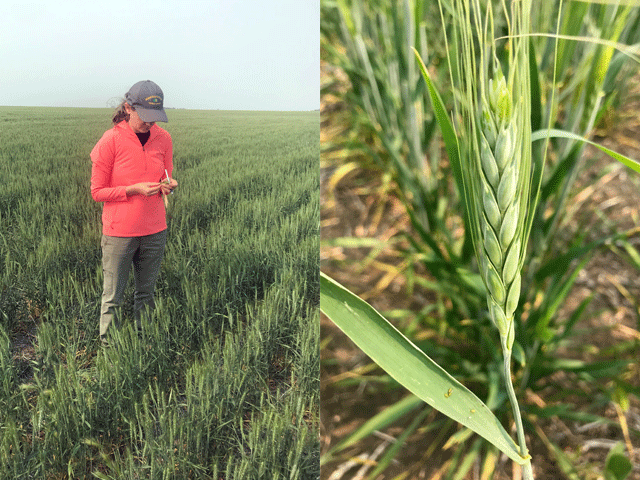Spring Wheat Tour: Day 2
Spring Wheat Tour Scouts Calculate Day 2 HRS Yield of 24.6 BPA, Durum 23.6 BPA
OMAHA (DTN) -- On Day Two of the 2021 Hard Spring Wheat and Durum Tour, scouts were not expecting to see good stands given much of the area traveled Wednesday have been in extreme drought conditions since the spring planting season, with rainfall picking and choosing what fields got a drink.
For the second day, the tour estimated the average calculated yield at 24.6 bushels per acre (bpa) for hard red spring wheat with 95 samples drawn. Durum yields were calculated at 23.6 bpa over 11 samples. The tour was canceled last year because of the pandemic. In 2019, the second-day totals over the same routes were calculated at 40.8 bpa for hard red spring wheat and 35.9 bpa for durum.
Dave Green, Wheat Quality Council executive vice president and tour organizer, told DTN as he arrived for the evening tour wrap-up meeting: "We went to the middle of the state, and it was as bad of a route as I've ever had to take. The average of all our fields was around 16 bpa. I've not heard yet what the other routes saw, but it was pretty dismal."
Green followed the blue route, which went north of Bismarck, to Turtle Lake and then east through McClusky and on to New Rockford and then, to Devils Lake, the final stop of Day Two.
P[L1] D[0x0] M[300x250] OOP[F] ADUNIT[] T[]
"It's ripe," he said of the wheat he saw, noting that much of it will likely be cut within the week. "The tiller counts are reduced, but that's not the big problem. They just are small heads; the wheat is very short and it doesn't have a lot of kernels. We only saw two, 20 bpa wheat fields today on our route. It's as dry as advertised."
He said wheat he viewed on the tour Wednesday looked to be of good quality, there's just not much of it. "The wheat (kernels) I saw look good. It's not shriveled. It looks like it is going to be fine," he said.
Phil Volk, chairman of the North Dakota Wheat Commission, drove the red route Wednesday, going north of Towner before heading east to Devils Lake. "We shelled out some kernels in some of the fields there, and they looked good. We saw more green fields up that way and especially over in Souris and Bottineau where they are at least six weeks away from maturity. If the green areas we saw today on our route get a rain, they could add some yield potential," Volk said.
Volk farms 2,000 acres of wheat in Benson County and said they are split by the drought. "Our fields near Minnewaukan got 2 inches of rain, while our fields 25 miles east of Rugby did not and are drought-stressed. There are some hilly spots that have wind erosion and will be difficult to try to harvest. We will harvest enough there for our seed wheat, and the bottom line is that we want our foreign customers to see that we will do our best to get them the best wheat possible, even with the drought conditions."
Volk added, "We all have to work through this together even though the vision we may have had when we planted this spring and even three or four weeks ago, has changed."
Green stressed again that the worst fields he saw Wednesday are as bad as any he's ever seen on this tour. "I did not see 1988, that was one of the two or three years I've missed. So, I was not here for the 15 bpa crop. But as far as my history on the tour, the totals I've seen today (on the blue route) were the worst I've seen," he said.
The tour will work its way back to Fargo on Thursday and have the final crop tour discussion around 1:30 p.m. CDT at Northern Crop Institute (NCI), Fargo.
Mary Kennedy can be reached at mary.kennedy@dtn.com
Follow her on Twitter @MaryCKenn
(c) Copyright 2021 DTN, LLC. All rights reserved.






